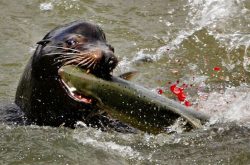
The Columbia River is home to one of the West Coast’s most important Chinook salmon runs. Through late spring and early summer, mature fish return from the sea and begin their arduous journey upriver to spawn. In recent years, these fish have faced an additional challenge: hungry California sea lions.
A new University of Washington and NOAA Fisheries study found that sea lions have the largest negative effect on early-arriving endangered Chinook salmon in the lower Columbia River. The results published Oct. 19 in the Journal of Applied Ecology.
Opportunistic sea lions have learned that by swimming as far as 145 miles upriver, they can easily feast on migrating salmon, including those hindered by the Bonneville Dam.
“We investigated whether mortality rates varied depending on the specific threatened Chinook salmon population, determined by when they arrive in the river,” said lead author Mark Sorel, a doctoral student at the UW School of Aquatic and Fishery Sciences. “We found that, based on their individual return timing and the abundance of sea lions in the river when they return, individual populations experience different levels of sea lion-associated mortality.”
Researchers learned that the earliest arriving populations of Chinook salmon experienced an additional 20% mortality over previous years, and the later arriving populations experienced an additional 10%. This increase in mortality was associated with increased sea lion abundance at those times of year in the period of 2013 to 2015 compared to the period of 2010 to 2012.
Read more at UW News »
